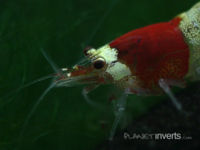Bee Shrimp (Caridina cantonensis sp.)
Bee Shrimp
Caridina cantonensis sp.
19 Litres (5 US G.)
2-3 cm (0.8-1.2")
Freshwater
6.2 - 7.2
20-24.4°C (68 -76 °F)
1-4 °d
2:3 M:F
1-2 years
This animal is available captive bred
Contents
Alternative names
- Bee Shrimp, Black Bee, Crystal Black Shrimp (original species often called CBS), Crystal Red Shrimp (colour mutation of the Black shrimp often called CRS).
Synonyms
- Caridina cantonensis sp. "Crystal Red", Caridina cantonensis sp. "Bee", Caridina cantonensis sp. "Black Tiger", Caridina cantonensis sp "blue", Caridina cantonensis sp. "Golden Bee", Caridina cantonensis sp. "Orange Bee"
Species Notes
- There are many selectively-bred colour morphs of the Bee Shrimp, established in 1991, it will commonly be found in stores as the Crystal Red Shrimp or CRS, the red/white variant. It is exactly the same as the Bee Shrimp but is now being bred separately for the colour.
- The Crystal Red genetic mutation was discovered in Japan in 1996 and was registered as a trademark in that country. It is like the Crystal Black but with red bands instead
Grading
- Crystal Red Shrimp/Crystal Black Shrimp have different grades. In order from lowest to highest, the grades are: C, B, A, S, SS, and SSS. The higher the grade, the more white it has and the more expensive it is. Visit external link below for grading information.
Other Morphs
- Other selectively bred morphs are appearing on the market regularly, including the Black Tiger Shrimp with a black body and red eyes. Also the Blue Tiger Shrimp with a very dark blue body and orange eyes.
- The Orange Bee Shrimp has very similar markings to the Tiger Shrimp but with a very orange body.
- The Golden Bee Shrimp has a solid white/cream body. It may also be called the Golden Crystal Red Shrimp or Snow White Crystal Red Shrimp.
- Many of these morphs may be reclassified with their own Caridina names as more is discovered about them.
Sexing
- The difference in sex is quite obvious in adult animals, especially if one can compare male and female.
- Adult females are 10-30% larger than adult males.
- Females have substantially larger scales on the abdomen (See image on the right)
- Before laying eggs, the female's ovaries are visible in the 'head' and back of the female.
- One of the few recognizable characteristics of young females, is the presence of ovaries before their first spawn.
- The extended scales of the female form a 'breeding chamber' for the eggs which are carried on the shrimp's swimming legs.
Tank compatibility
- A small peaceful shrimp. Best not kept with other members of the Cardinia family due to cross-breeding or aggressive or nippy fish.
Diet
- Provide a variety of leaf litter for the shrimp to graze on. Their primary food is the micro-organisms that grows on the submerged leaves. A natural environment with leaf litter, mosses and plants provides the shrimp with everything they need for a staple diet. Feeding commercial foods should be seen giving a treat, not a regular meal.
Feeding regime
- Feed sparingly. Commercial packet foods should be given as a treat rather than a stable diet. Feed fresh leaves such as spinach, nettles and dandelion.
Environment Specifics
- These shrimp are highly sensitive to water conditions. They need an ammonia and nitrite free tank. Although they will graze on algae, the presence of algae represents a heightened nitrate level, which will also effect the shrimp. They prefer a neutral to slightly acidic pH. Seem to breed well when doing water changes with R/O water. These shrimp prefer lower water temperatures around a low 21.1°C (70°F) . Temperatures about 24.4°C (76°F) stress them out and they won't breed readily and may even die. Many keepers of these shrimp install fan systems to keep the tank cool during warm weather.
Behaviour
These invertebrates are active explorers, constantly foraging for food and meticulously cleaning the substrate and surfaces. Their small size and agile movements make them agile climbers and adept at navigating intricate aquarium landscapes. Dwarf shrimp are social creatures that often engage in communal activities, forming hierarchies within their groups. Breeding behaviors, such as molting and courtship rituals, are common sights, adding an engaging dimension to their overall behavior. Despite their diminutive size, these shrimp showcase complex interactions and contribute to the dynamic ecology of a well-maintained aquarium.
Identification
- An attractive shrimp with many colour morphs, see above.
Pictures
Commercial Sellers
- PodvodoyAquatics.com - USA Seller
- BreedInUSA.com - USA Breeder & Seller
- The Shrimp Spot - Worldwide Seller of Freshwater Shrimp
- British Reds - UK Shrimp Store
External links
- PodvodoyAquatics.com - USA Seller
- Shrimp Keeping - The Home of Freshwater Shrimp
- BreedInUSA.com - US Seller: Crystal Red Shrimp
- Planet Inverts - Crystal Red Shrimp
- Planet Inverts - Black Tiger Shrimp
- Planet Inverts.com Crystal Red Shrimp Grading Guide
- Shrimp Fanatics
- Fish You
- The Shrimp Farm
- Caring and Breeding Crystal Red's
- Breeding CRS shrimp for profit







